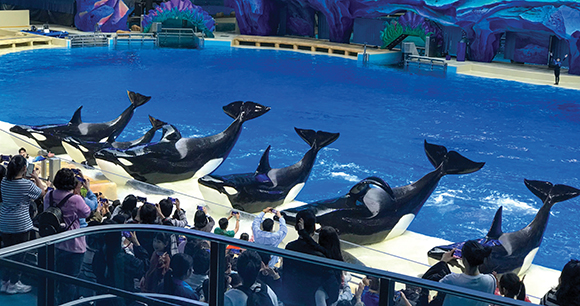AWI’s Dr. Naomi Rose visited China in January on behalf of the China Cetacean Alliance, of which AWI is a founding member, to observe the orcas living in Chinese facilities. She also gave public presentations to eager audiences in Shanghai and Hangzhou on the welfare of captive cetaceans.

China now has 22 captive orcas—15 imported from Russia’s Sea of Okhotsk and seven captive-born. The oldest of the latter is 4 years old and already performing. The wild-caught orcas in China all arrived between 2013 and 2016, but were not immediately put on public display. (Two still aren’t, but a video of a May 2023 training session with them at Changqiao Ocean Kingdom in Wuxi was posted to Instagram in January.) The two adult females at Haichang Ocean Park in Shanghai—first displayed in 2018—were due to give birth by the end of 2023. Naomi, however, observed only one calf of the right age, alone in the medical tank, being raised by hand. A 2-year-old at the facility, now with the adult females, was also hand raised after being rejected by his mother.
Most of China’s orcas were only put on display in autumn 2023, in a brand-new facility in Zhuhai called Chimelong Spaceship. Naomi saw six male orcas perform at this facility, which has the largest cetacean enclosure in the world at 36 feet (11m) deep and long enough to accommodate a wave machine at one end for enrichment. The juveniles did seem to enjoy surfing, but the waves are only available twice a day, before and after performances. At two locations, floor jets shoot up curtains of bubbles, but Naomi did not see any of the animals interact with the bubbles during the time one set of jets was on. Two of the males are adults, whose fins have already collapsed. Despite the bubble and wave features, all six males have developed significant stereotypical behaviors, including repetitively approaching an underwater viewing window and bumping it with their foreheads or bellies—a sign of boredom or frustration. Four large viewing windows surround the enclosure, so when visitors are present, the whales cannot go “off view”—an option many zoo specialists consider important for welfare.
A second tank held three juveniles of around 1 month, 1 year, and 2 years of age accompanied by one adult female. She is believed to be the mother of the oldest and youngest of the three, while the 1-year-old has already been separated from their mother. The remaining four orcas (three wild-caught and one more calf) are reportedly held at the off-site “breeding center,” where all the whales were until last autumn, but there is no way to confirm this, as that facility is not open to the public.
China is going in the opposite direction to the rest of the world with regard to captive orcas. Russia outlawed capture of orcas within its waters in 2018, so now China will only be able to maintain its “collection” through breeding. With inbreeding a looming concern, the future of the Chinese orcas is uncertain. AWI will continue to do its utmost to increase awareness in China about the welfare issues associated with orca captivity and to influence Chinese authorities to reconsider their regressive choices.